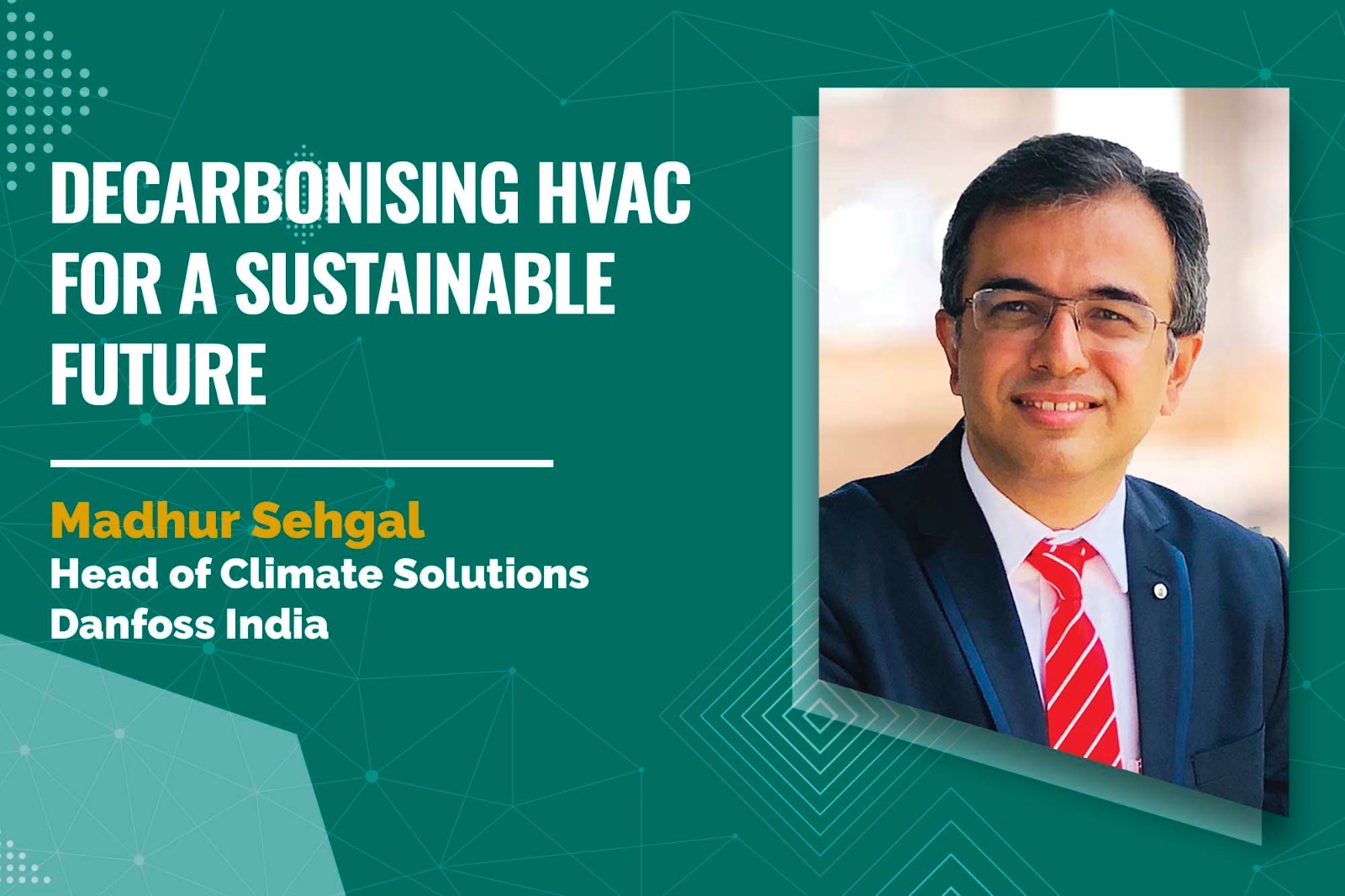According to Madhur Sehgal, Head of Climate Solutions, Danfoss India, the HVAC industry is gearing up with interconnected technologies and sustainable transformation with the emergence of District Energy solutions. Leveraging district heating, combined heat and power, and decentralised energy, this technology addresses climate challenges and creates eco-friendly indoor spaces.
How are the District Energy initiatives addressing the challenge of carbon emissions from building operations?
The World Green Building Council highlights– approximately 28 percent of global CO2 emissions stem from building operations, underlining the significance of energy consumption in heating, cooling, and powering structures. This revelation positions the building sector as a major emitter to the ongoing challenge of reducing CO2 emissions worldwide. It includes comfort cooling for homes and buildings and temperature control in industrial processes. It also includes the cold chain, ensuring safe food, medicine, and vaccine delivery worldwide. We have witnessed 2023 as one of the warmest years in this century, as cited by the UN weather agency, WMO.
The good news is that innovation exists to increase energy efficiency and decarbonise heating, cooling and ventilation while creating comfortable, healthy indoor spaces. The District Energy is a UNEP initiative that will be an emerging trend which promotes energy-efficient district systems. This technology can help cut carbon dioxide emissions by 58 percent in the energy sector by 2050. These systems – which combine district heating or cooling with combined heat and power, thermal storage, heat pumps and decentralised energy seek to share energy resources among buildings and across neighbourhoods and cities. The district energy solutions include a full range of automatic controls that can be built into a district heating or cooling system on-site.
Today, combining solutions for air conditioning, cooling, and heating needs can be offered using heat pump technologies and natural refrigerants like Co2 and Ammonia. These technologies are highly efficient compared to conventional technologies using HFC/HCFC’s. These also provide a sustainable solution in the long run.
Every year, the HVAC industry steps up its processes and upgrades itself to support the environment better. 2024 will be no different, as decarbonisation will remain a major focus. Part of that is because industry standards are shifting, and consumers are becoming more aware and looking for sustainable HVACR solutions.
Please discuss the advantages of remote monitoring and control of HVAC systems through IoT connectivity in optimising performance.
In the HVAC industry, the Internet of Things (IoT) is revolutionising the process. Smart meters and sensors are being incorporated into IoT connectivity at an unprecedented rate. This technology allows HVAC systems to be remotely monitored and controlled, providing real-time data on various parameters and enabling predictive maintenance. It is possible to anticipate potential problems before they occur, ensuring minimal downtime and optimising performance.
How are interconnected HVACR technologies contributing to the sustainable transformation of supply chains?
Artificial Intelligence (AI), Machine Learning (ML), and other emerging technologies are playing a crucial role in driving the transformation of the HVAC industry. In today’s digital era, these technologies have been successfully scaled up to enable end-to-end supply chain transformation, enhance daily operations, and foster innovation and automation, ultimately leading to customer satisfaction.
We have embraced end-to-end digitalisation to enhance our supply chain resilience and efficiency. This includes integrating suppliers into our digital supply chain ecosystem, enabling seamless collaboration, performance tracking, and efficient procure-to-pay processes. We also leverage touchless sales solutions to provide a streamlined and sustainable customer experience. These digital initiatives optimise operations, streamline processes, and minimise environmental impact.
How do AI and ML algorithms contribute to optimising HVAC operations and energy efficiency in systems?
AI and ML algorithms are utilised to analyse large volumes of data and gain valuable insights. By leveraging these technologies, we can optimise operations, predict maintenance needs, and improve energy efficiency in HVAC systems. Analysing data in real time allows for proactive decision-making and identifying patterns or anomalies that can help streamline operations. Furthermore, these technologies facilitate the development of advanced HVAC systems and components. Manufacturers can design and produce cutting-edge products that meet evolving customer needs through innovation and automation. AI and ML algorithms aid in the creation of intelligent HVAC systems capable of self-adjusting based on real-time conditions, optimising energy usage, and enhancing comfort levels.
Please elaborate on the role of Cloud-based monitoring and control systems in providing real-time data.
The HAVCR systems are transforming with trends like condition monitoring, integrated energy systems management and real-time energy consumption monitoring. Cloud-based monitoring and control systems provide real-time data on equipment performance, energy consumption, and environmental conditions. This system provides a holistic view of how various energy-efficient products work in a synchronised way to contribute towards the overall functioning of the HVACR by leveraging AI and machine Learning tools. It offers a competitive edge to reduce carbon footprints and the cost of ownership.
The intelligent drive, e.g., VFDs (variable frequency drives), enables early detection of potential problems in electrical equipment before they cause a system failure and offers advanced monitoring and control features, such as vibration analysis, temperature, and motor current monitoring. It prevents equipment downtime and reduces maintenance costs. We can easily generate and store valuable insights from intelligent drives over the cloud or other on-premises systems to improve matters.
The widespread adoption of smart thermostats is a significant shift in the HVAC industry. According to a report, more households are expected to have smart thermostats. These devices give users unprecedented control over their home’s temperature, allowing for customised settings based on time of day and occupancy levels. Overall, these improvements in monitoring technology and systems help to increase efficiency, reduce downtime, and lower energy costs, leading to a more sustainable and profitable operation.
Cookie Consent
We use cookies to personalize your experience. By continuing to visit this website you agree to our Terms & Conditions, Privacy Policy and Cookie Policy.















